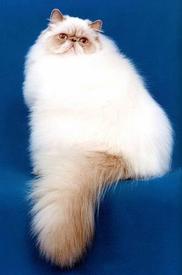
Thought to have descended from wild cats found in central Asia, the Himalayan or Colorpoint Persian is a distinctive cat breed whose development was no accident. It is believed that the Himalayan first appeared in 1931 when two members of Harvard medical staff, Clyde Keeler and Virginia Cobb, deliberately crossed a Persian and a Siamese to analyse inherited characteristics. Far from intending to produce a new breed, the pair was pleasantly surprised with the offspring of black, short-haired kittens. Others were equally taken by the litter, and as a result further selective breeding was conducted. Eventually, a cat possessing the coat patterning and structure of the Siamese and the long hair of the Persian emerged. Many admirers, including the Cat Fanciers Association recognise the Himalayan as a variation of the Persian, rather than an independent breed in its own right.
Described as having a ‘cobby’ body, the Himalayan is a robust-looking breed of medium to large size, boasting a domed head, small ears, a thick neck, a pinched expression and a profuse coat. The Himalayan also has short legs which reduce its ability to jump and climb to some extent. Nowadays, two variations of the Himalayan are recognised. These include the traditional breed, or ‘Doll Face,’ and the more extreme-looking ‘Peke-Faced’ variation, with accentuated facial ‘squashing.’ Many breeders, owners and enthusiasts dislike the type of selective breeding that attempts to preserve and exemplify this ‘squashed’ facial appearance, believing that it causes a great deal of suffering for the cat. Colour deviations observed in the breed include lilac point, blue point, seal point, cream point, chocolate point, and red point.
In line with Persian behaviours and temperament, the Himalayan is typically a quiet and docile breed that demands little attention. Content with the simple things in life, a Himalayan will be more than happy curled up on the sofa or on a warm window-ledge where it can relax, whilst still being party to goings on in the house. Despite this, the Himalayan is not an inactive breed and enjoys plenty of exercise and play in its everyday life. Providing a variety of interactive toys for your Himalayan is essential, as this will keep it occupied and enriched throughout the day. Not very vocal, this cat will communicate softly if it wants your attention. On average, a healthy Himalayan will weigh 8-12 pounds, with a life expectancy of 15-18 years.
The Himalayan is susceptible to several hereditary health conditions, ranging from mild to more severe. These include heat intolerance (associated with most flat-faced breeds) as well as various breathing difficulties arising from the breed’s squashed features. Polycystic kidney disease is another serious affliction that is prevalent in the Himalayan. Always make sure you purchase from a responsible breeder that has carried out health checks on their cats.

VetMedsDirect has been working alongside VioVet to bring you a wider range of products, including prescription medications. VetMedsDirect has been owned and run by VioVet since 2015, and has been operating since then from the same premises in Luton, Bedfordshire.
VetMedsDirect has now been fully merged with VioVet. If you had an account with VetMedsDirect you can securely login with your same details on the VioVet website and there will be no delay or disruption to the supply of your pet products.
Thank you for being a VetMedsDirect customer, we are confident that you will be just as satisfied with what VioVet can offer you and your pets!
If you'd like more information about the company merge, you can read more on our blog.
Do you own a Himalayan/Colorpoint Persian? Let others know what they're like!
Related products
Advantage 80 Spot On Flea Control Large Cats and Rabbits
from £12.95
Advantage 40 Spot On Flea Control Cats, Small Dogs and Rabbits
from £12.95
Advantage 250 Spot On Flea Control Large Dog
from £12.95
Advantage 100 Spot On Flea Control Medium Dog
from £12.95
TermaWorm™ Tablets for Cats & Dogs
from £1.59
Drontal Tasty Bone Wormer Tablets for Small & Medium Dogs (2 to 20kg)
from £2.15
FRONTLINE Plus Flea & Tick Treatment Dogs & Cats
from £17.49
Drontal Tasty Bone XL Wormer Tablets for Large Dogs (Over 20kg)
from £6.39